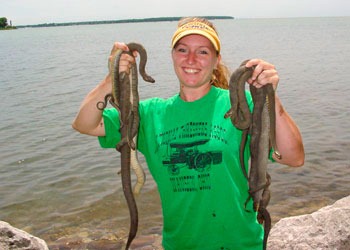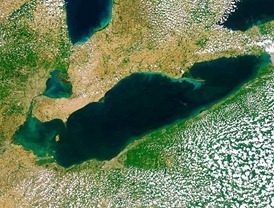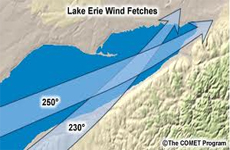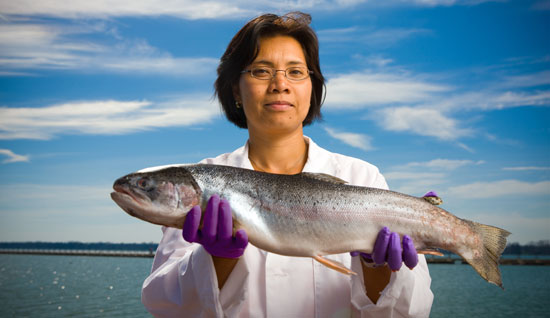Lake Erie water snake population booming
4
Kristin Stanford
After nearly a decade of decline, the Lake Erie water snake is making a comeback. It’s been listed as threatened by the U.S. Fish and Wildlife Service but could be removed from the watch list soon, according to WEWS-5 ABC. The snakes are native to the Lake Erie Islands and are typically grayish in color. They are nonvenomous and feed mainly on round gobies.
“When the snakes were first listed, it was estimated there were only 1,000 to 2,000 animals left on the Lake Erie Islands,” Kristin Stanford, a researcher at the Ohio State University’s Stone Laboratory told WEWS-5. Stanford said the snake population was now at about 12,000. She also credited the population’s recovery to the high numbers of round gobies. However, Stanford also deserves credit for the watersnake’s recuperation.
Stanford, better known as “the Snake Lady” by Lake Erie Island locals, began her campaign to save the threatened snakes as a graduate student at Northern Illinois University in 2000, according to Ohio Sea Grant’s Twine Line. The USFWS listed humans as the primary cause for the species’ dwindling numbers, so Stanford enacted a multifaceted plan to save the native snake. She aimed to accomplish three objectives: change public opinion concerning the snakes, increase their population, and create a safe place for them to live.
Stanford, in the process of educating herself about the watersnake, took on various approaches to engage and educate the public. As part of her campaign, she spoke at public schools and instructed herpetology classes at The Ohio State University’s Stone Lab. She also launched a Lake Erie water snake newsletter and is the author for the “Ask the Snake Lady” column in local newspapers. However, Stanford’s best way of reaching the public may be her indelible presence as she catches, tags, and releases watersnakes.
Stanford has received various forms of recognition for her work. One of the more memorable was an appearance on Discovery Channel’s ‘Dirty Jobs’, where host Mike Rowe joined her in a tagging and catching expedition. Another was being a joint recipient of two of the 2010 the National Endangered Species Recovery Awards. Both she and fellow watersnake researcher Dr. Richard King from Northern Illinois University were honored for their work in rehabilitating the snake’s population, including creating a habitat for them.
“Rich and I were definitely humbled to be in the company of other recipients,” Stanford told Twine Line. Despite the watersnake being safe from extinction, Stanford said she has no plans to quit donning her “Snake Lady” identity.
“Many people assume that this is the end of the story, but I don’t think that’s the case,” she told Lake Erie Living Magazine. “I think snake education will keep me busy for a lifetime.”
The Snake Lady [Lake Erie Living Magazine] From the Brink: Researcher’s efforts lead to recovery of threatened snake species [Ohio Sea Grant Twine Line] About LEWS [Respectthesnake.com] Watersnake population explodes throughout Western basin of Lake Erie [Newsnet5.com] Dirty Jobs Mike Rowe, Kristin Stanford, Island Snake Lady [YouTube]
Image Credit: Courtesy of Kristin Stanford /http://www.fws.gov/midwest/news/release.cfm?rid=199













Non-venomous, not nonpoisonous
Thank you for the correction; I’ll be sure to remember that in my future projects.
I think you are a very wonderful woman and thank you for your hard work in helping the wildlife 🙂
I appreciate the acknowledgement of Venomous instead of Poisonous, but you should edit it because most people won’t read the comments.